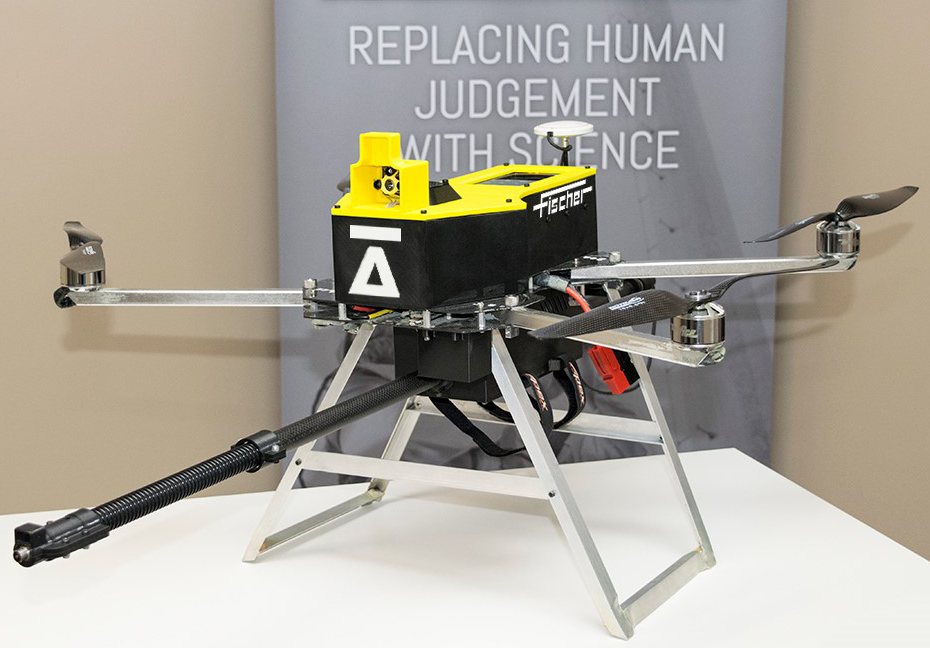The initial beta phase of a novel, computer-assisted drone to take dry film thickness (DFT) and surface profile measurements is expected to launch in August 2017, according to officials with software-controlled aerial robotics company Apellix (Jacksonville, Florida).
Called the “Smart Bee,” the drone utilizes specialized software, sensors, and an electronic coating thickness gauge system to collect and record nondestructive DFT millage thickness measurements. It eliminates the need for scaffolding and cranes, keeps workers safely on the ground, and improves productivity by up to 15 times—all while automatically recording every measurement with the time, data, photo confirmation, and additional project data, CEO Robert Dahlstrom explains.
 “I see drones as flying computers,” says Dahlstrom, who has a software background from a prior role at an Internet software security company. “And if you’re a flying computer, you’re software. It’s amazing what you can do with software.”
“I see drones as flying computers,” says Dahlstrom, who has a software background from a prior role at an Internet software security company. “And if you’re a flying computer, you’re software. It’s amazing what you can do with software.”
“The mindset from people in the drone industry has largely been that these things fly far and fast, but don’t fly close to structures,” Dahlstrom adds. “What we’re doing is counter-intuitive. We fly slow, and we fly close. When I went to a drone conference a couple of years ago and showed people there the video, they were amazed.”
The DFT drone, which can fly to a specific location such as a ship’s hull, was named a recipient of a 2017 Corrosion Innovation of the Year Award, presented by Materials Performance (MP) magazine.
“We can do in a day what it typically takes ship manufacturers at least a week to do,” Dahlstrom says. “The traditional processes often takes about six people, seven days, and four cranes. With this, we can do it all in one day with just one person, who keeps his feet on the ground the whole time.”
How It Works
The patent-pending technology consists of a base station with a portable computing device, such as a laptop or tablet, and a high-resolution video display; an unmanned aerial vehicle (UAV), or drone, with attached sensors, a video camera, and a DFT probe; and specialized software with embedded systems for flight control and communications of the DFT measurements.
The system operator flies the aircraft to within close proximity of the location where the DFT measurement is to be taken and recorded. Then, with computer-assisted flight from the onboard distance and other sensors, the operator is able to “touch” the wand/probe to the surface—where the DFT measurement is taken. The DFT readings, and the general location of the measurement, are then recorded.
The “spot measurement” data are in full compliance with the SSPC-PA21 standard, where three gauge measurements are taken and averaged for each recorded spot measurement. In addition, the raw data from the measurements and averages are made available for compliance and auditing purposes.
In addition to time and efficiency, the system developers believe increased safety is another key benefit. “Currently, you have to use a lift, scaffolding, ladders, or other access solutions to reach areas of height to take DFT measurements,” Dahlstrom says. “This is both dangerous, due to the possibility of falls, and time consuming. Our solution allows the operator to remain safely on the ground the entire time.”
The developers also believe the system could boost the overall accuracy of DFT measurements, since the drone could enable the collection of data from locations where data were previously either inaccessible or very difficult to obtain.
“We can increase the confidence that the measurement captures the true quality of the coating,” Dahlstrom says.

Starts with Maritime Industry
The company launched its web site in February 2016 after beginning development of the DFT and other software-controlled drones about two years earlier. Within weeks, and after attending a few industry conferences, the CEO received positive feedback from the maritime industry in particular.
“The larger ship manufacturers were so excited, because it can save them so much work,” the CEO says. “We asked them what the most painful steps are for them, and they all said quality assurance. They said it took them a full week, and that’s assuming good weather!”
Based on strong early interest, the beta phase was targeted toward the maritime industry—and namely, larger industrial customers at high volumes. Because of the unprecedented approach, the developers wanted to limit the initial commercial rollout to a small industry subset that they could closely monitor and work with. Eventually, the company plans to make its products available for smaller users.
“With a complicated robotic situation like this, the ship creates its own magnetic field,” Dahlstrom says. “We’re relying on data. We have to have supplementary systems in place to prepare for the possibility that when we do fly it next to a ship, it could impact the flight. We want to make sure that it’s not going to be a problem.”
As a result, the initial wave of DFT drones used commercially—scheduled to begin in mid-to-late August—will consist of a select handful of larger companies who will lease the product from the developers and work in collaboration on the runs.
“If you bought a helicopter, you don’t buy a helicopter without a flight crew and maintenance plan,” Dahlstrom says. “You want to make sure that every time you take it in the air, it’s safe. Our clients are leasing it as a long-term lease. That way, they get a product with our full backing and support. We work closely with our beta users.”
Specifically, the development team is still working on improvements to the user interface. The company aims to further refine the drone so that it is something a manufacturer and an engineering firm can lease and feel confident that a licensed pilot can walk up and operate it safely and efficiently.
“That requires a lot of little details to be done, to make sure the user interface is working smoothly,” Dahlstrom says.
The company says it is in discussions with ship manufacturers and engineering firms in North America, Central America, and Europe for the beta phase rollout. Shipyards could also potentially use the product, Dahlstrom adds.
Other Substrates, Models
The decision to start with the maritime market was largely based on the overwhelming initial response.
“We know there’s a ready and willing market there,” Dahlstrom says. “We know it will have a huge impact. So we want to concentrate on getting one working well, and then we can move on to others.”
“It’s just as applicable to other substrates,” the CEO adds. “Aboveground storage tanks and pipelines could definitely use this, and we are in discussions with several engineering firms on non-maritime applications. But we’re not yet to the [final] stage on those.”
In addition to the DFT drone, the developers are working on a separate “Worker Bee” model that workers as a tethered, drone-based painting platform for larger-scale vertical surfaces. The company is currently conducting feasibility studies on this version, and the goal is for a water-based production painting aircraft to become commercially available by the fourth quarter of 2017.
“With the painting drone, we can bring the efficiency of a factory to the application of paints,” the CEO says. “Right now, there’s a lot of variance based on the individual that’s doing the application.”
The painting drone can potentially be used in tandem with the DFT drone for an end-to-end solution.
“The value equation is just so high,” Dahlstrom says. “Our customers have said they want it last week!”
Source: Apellix, www.apellix.com. Contact Robert Dahlstrom, Apellix—Email: r.dahlstrom@apellix.com.
Reference
1 SSPC-PA 2, “Procedure for Determining Conference to Dry Coating Thickness Requirements” (Pittsburgh, PA: SSPC).